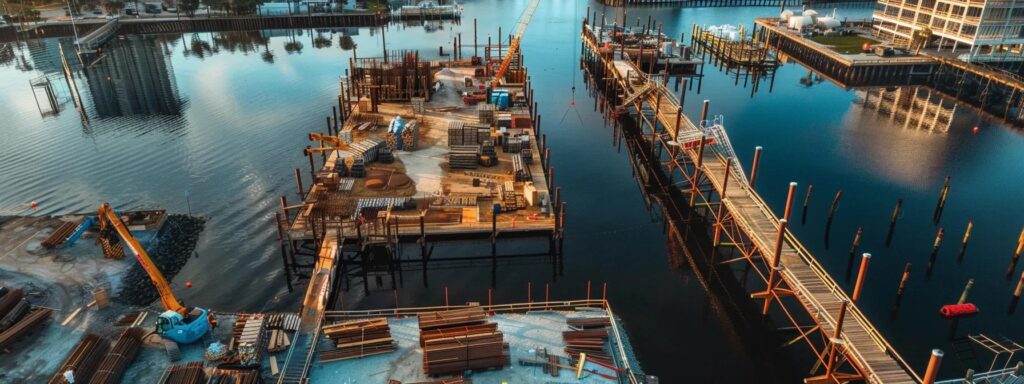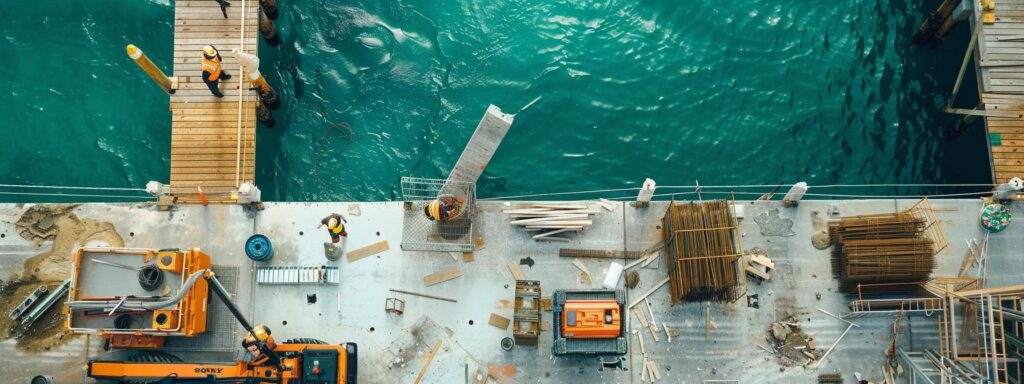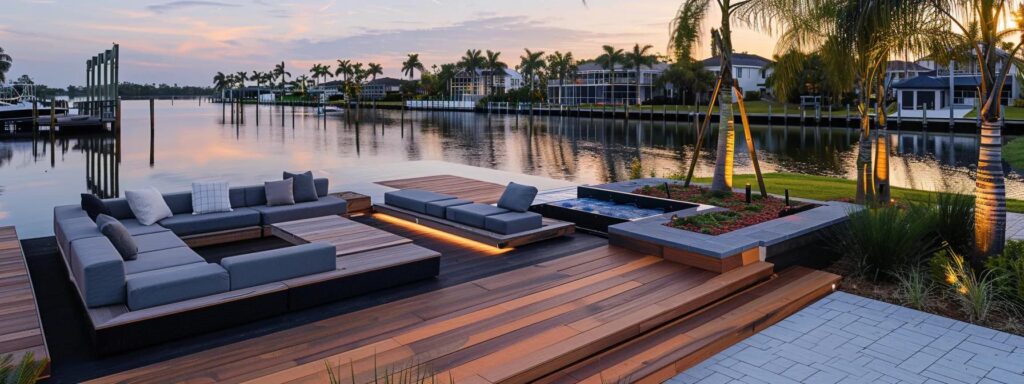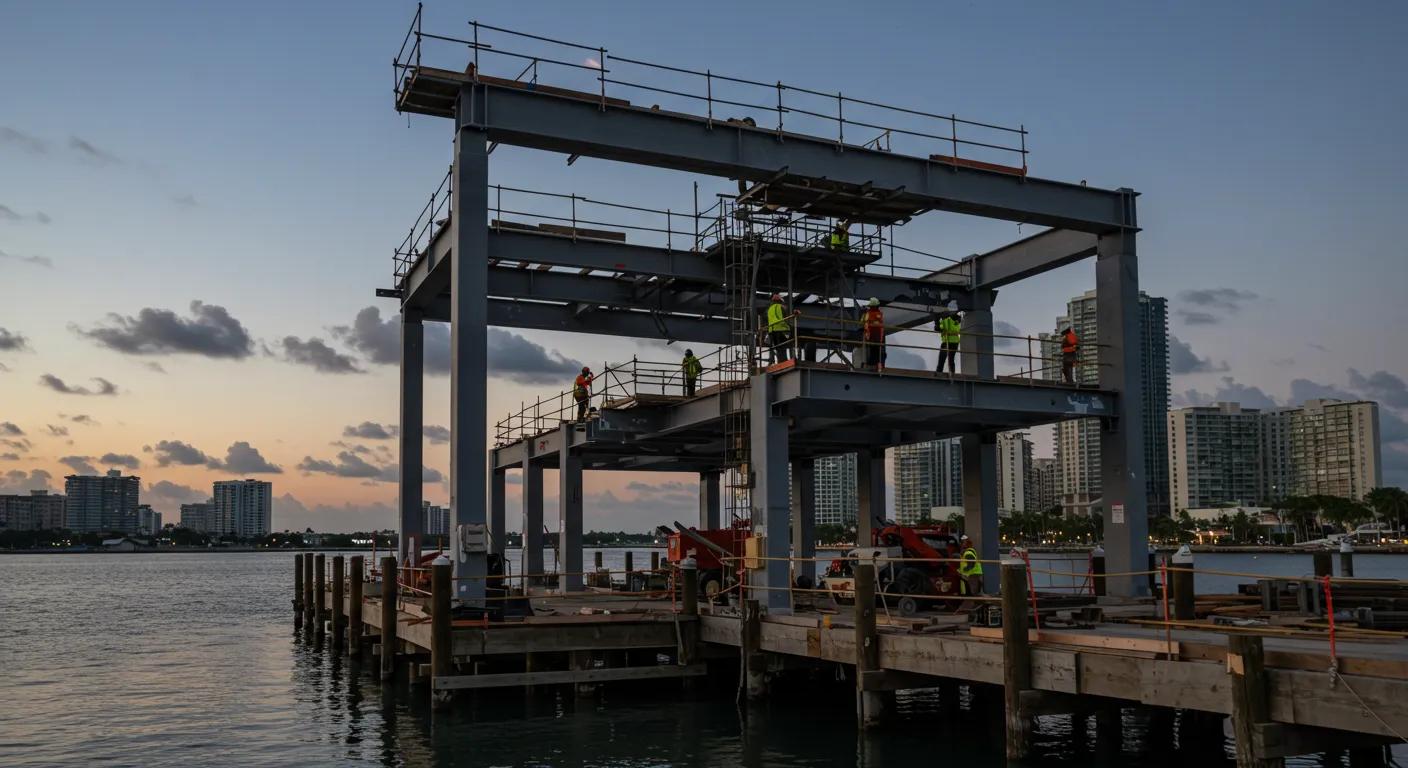Custom Dock Layout vs Standard Designs: Which Is Best?
Introduction
Customizing your waterfront access can be a challenging decision. As a homeowner considering an investment in dock construction, you may wonder whether a standard dock design meets your needs or if a custom dock layout is the optimal solution. This article reviews both options including their characteristics, advantages, limitations, and real-world applications. We discuss factors such as safety, longevity, efficiency, materials, and overall cost. By comparing these two approaches, you can decide which aligns best with your waterfront lifestyle, desired aesthetics, and long-term investment goals. Our insights are based on decades of craftsmanship by All American Installers and are intended to help you navigate permitting, budgeting, and maintenance challenges while choosing the perfect dock solution.
Defining Standard Dock Designs and Their Common Applications

Standard dock designs are pre-engineered models offering a predictable layout and configuration for waterfront projects. These docks typically incorporate commonly used materials such as wood, metal, or plastic that resist water damage, corrosion, and wear. Their mass-produced nature makes them cost-effective and reliable for homeowners who need a straightforward dock without extensive customization.
Understanding Prefabricated Dock Kit Characteristics
Prefabricated dock kits feature a uniform design engineered for common watercraft operations like docking for boats, canoes, or rowboats. Their consistent structural properties ensure stability in moderate marine environments such as lakes and calm inland waters. These kits usually integrate ladders and safety railings, and use standard polymers, metals, or treated wood. Such materials help optimize longevity and reduce maintenance challenges in areas prone to water damage and even flooding.
Typical Uses for Standard Dock Configurations
Standard dock configurations are common in residential marinas and lakefront properties. Homeowners choose them for straightforward projects that do not require complex engineering. Their off-the-shelf availability allows for instant installation with minimal downtime. Whether used for a boat lift, protection against water damage, or as a safe landing area for small watercraft, standard docks balance cost efficiency, aesthetics, and the practical demands of waterfront living through modular construction and easy assembly.
Advantages of Choosing a Standard Dock Layout
Standard docks offer several benefits: • Lower cost due to mass production • Streamlined installation with modular, uniform parts that reduce labor time • Built-in safety and efficiency features such as integrated walkways and secure ladder placements • Often include warranties and manufacturer support for long-term durability
Limitations Associated With Standard Dock Options
Despite their benefits, standard docks have limitations. Their generic design may not suit unique site conditions like unusual water depth, irregular shoreline contours, or specific aesthetic preferences. Homeowners with distinctive properties might find it challenging to incorporate features such as specialized ramps or custom ladder placements. Furthermore, while the materials are reliable, they may not fully address long-term issues associated with harsh climates or heavy usage.
Exploring the Flexibility of a Custom Dock Layout
A custom dock layout allows for a design tailored to your specific needs and the unique conditions of your property. Custom docks are fully engineered to optimize material selection, load-bearing capacity, aesthetics, and integration with surrounding structures. Although more expensive initially, the bespoke nature of a custom dock can outweigh the extra cost over time, especially when property challenges require specialized design adaptations.
Tailoring Your Dock to Specific Waterfront Needs
The main benefit of a custom dock layout is its adaptability to your property’s unique conditions. If you live near a lake with fluctuating water levels, a custom design can incorporate adjustable flotation devices or reinforced anchoring systems. Custom docks can also be engineered to support a variety of watercraft—from yachts and canoes to rowboats—by specifying weight tolerances and incorporating features like integrated boat lifts or specialized docking bumpers. This targeted design maximizes both safety and efficiency.
Incorporating Unique Features in a Custom Dock Layout
Customization allows the inclusion of unique features not available in standard designs. Options may include integrated lighting systems, non-corrosive custom railings, or eco-friendly components such as solar-powered pumps. Using biodegradable composite decking can provide durability while keeping the dock environmentally friendly. Artistic touches like engraved motifs or bespoke color schemes can also be added, making your dock a personalized extension of your home.
Benefits of a Personalized Dock Configuration
A personalized dock configuration offers long-term advantages: • Enhanced operational efficiency and safety tailored to specific environmental stresses (e.g., high winds or heavy usage) • Superior longevity due to the use of premium, durable materials • Improved property aesthetics and potentially increased resale value A dock that complements your home’s style and meets your unique usage needs creates a cohesive outdoor living space.
Potential Downsides of Opting for a Bespoke Dock Design
Custom docks come with downsides that require consideration. They involve a higher initial cost due to bespoke design and specialized engineering. Design and labor costs can escalate, and lead times are typically longer because of detailed planning and permitting requirements. Additionally, overly customized features might complicate future modifications and may demand a higher level of ongoing maintenance.
Key Custom Dock Layout Considerations for Optimal Functionality

When opting for a custom dock, several factors are critical to ensure both functionality and future adaptability. A careful evaluation will help design a dock that meets your current needs and can adapt over time to changes in usage, environmental conditions, and maintenance requirements.
Assessing Your Property for a Custom Dock Layout
The first step in planning a custom dock is a comprehensive property assessment. This includes evaluating water depth, shoreline composition, and prevailing weather conditions. Properties prone to flooding or high winds require designs focused on stability and safety, using high-grade metal or composite decking. A professional site analysis, including geotechnical surveys and hydrological assessments, helps determine if additional safety features like flood barriers or reinforced pilings are needed.
Material Selection in Custom Dock Layout Planning
Selecting the right materials is critical for durability and ease of maintenance. Homeowners must consider options such as treated wood, metal, or plastic composites. While wood offers a traditional appeal, it requires regular maintenance to prevent water damage. Metal components, especially when treated to resist corrosion, provide superior longevity, particularly in saltwater or humid climates. Environmentally friendly polyethylene and composite materials offer a balance between sustainability and performance.
Navigating Permitting for Your Custom Dock Layout
Securing the proper permits is essential before beginning construction. Permitting requirements can vary by jurisdiction and involve zoning, water usage, and environmental protection regulations. Working with experienced contractors who are familiar with local permitting processes can help streamline this phase and prevent costly delays.
Budgeting Effectively for Custom Dock Layout Projects
A realistic budget is key for custom dock projects. Beyond initial construction costs, homeowners should factor in long-term maintenance and potential upgrades. It is wise to include contingencies for unexpected expenses such as permit delays or changes in material costs. Obtaining multiple quotes and exploring financing options can help manage the investment.
Anticipating Future Needs With Your Custom Dock Layout
A forward-thinking design incorporates flexibility for future changes. As your waterfront lifestyle evolves, consider modular components that can be expanded or modified easily. Technological integrations, such as automated boat lifts or smart safety systems, may also be incorporated. Planning for ease of access for repairs and replacements ensures that your dock remains adaptable and valuable over time.
Comparing Costs Standard Dock Designs Versus Custom Approaches
Cost is one of the most important factors in choosing between a standard dock and a custom layout. While the initial investment for standard docks is usually lower, long-term financial implications, such as maintenance and eventual replacement costs, must also be evaluated.
Initial Investment Differences Between Standard and Custom Docks
Standard docks benefit from economies of scale and have streamlined construction processes, leading to lower upfront costs. In contrast, custom docks require specialized materials and tailored design work, often costing 20% to 50% more initially. However, this investment can be justified by the improved longevity and reduced maintenance of a custom design.
Long-Term Financial Aspects of Dock Choices
Long-term considerations include maintenance frequency, replacement needs, and the impact on property resale value. Standard docks may require periodic replacement of components exposed to water damage and weathering. Custom docks, built with premium materials and engineering, typically offer superior durability even in harsh climates. Over time, the reduced upkeep and potential warranties associated with custom docks may balance the initial cost difference.
Resale Value Impact Standard vs Custom Dock Layout
A well-designed dock enhances property appeal and can increase resale value. Custom docks signal high-quality craftsmanship and personalized functionality, potentially leading to a higher asking price. While standard docks are functional and reliable, they may not provide the same premium market appeal.
Making the Right Choice Your Guide to Selecting a Dock Layout

Choosing the right dock layout depends on your property conditions, lifestyle preferences, and long-term goals. Carefully consider upfront and ongoing costs, as well as how each option meets your practical and aesthetic needs.
Matching Dock Type to Your Lifestyle and Activities
Your daily and seasonal activities are key in determining the appropriate dock type. For casual boating, fishing, or light water sports, a standard dock can be sufficient. However, if you plan on hosting gatherings or require advanced features like integrated boat lifts for yachts or specialized watercraft, a custom layout may be necessary. Matching the dock’s design to your lifestyle enhances accessibility, safety, and user satisfaction.
Evaluating Site and Environmental Conditions
Assess the environmental conditions at your waterfront—including water levels, currents, and soil stability—to determine whether a standard design is viable or if a custom dock is needed. Professional surveys can provide the accurate data required to design a dock that minimizes water damage risks and maximizes stability.
Balancing Aesthetic Appeal with Practicality
Aesthetic considerations are important, but they must be balanced with practicality. While standard docks provide a uniform look, custom docks allow you to choose materials such as natural wood, sleek metals, or eco-friendly composites that complement your home’s design. Consulting with design professionals can help create a dock that is both visually appealing and functionally robust.
When a Standard Design is Ideal
Standard dock designs work well when budget constraints and quick installations are priorities. They are ideal for properties with typical water conditions and for homeowners seeking a reliable, easily maintained solution without the need for extensive customization.
Knowing When a Custom Dock Layout Is the Superior Option
A custom dock layout is the better choice if your property presents unique challenges or if your lifestyle requires specialized functionality and aesthetics. For properties exposed to extreme conditions or for those needing advanced features, the higher initial cost of a custom dock can be justified by its long-term benefits, including enhanced durability, increased safety, and improved property value.
Maintenance and Longevity Standard vs Custom Dock Layouts
Maintenance is critical for extending the life of your dock while preserving safety and aesthetics. Both standard and custom docks require periodic attention, though the nature of maintenance varies with design and materials.
Upkeep Requirements for Standard Dock Materials
Standard docks, constructed from widely available materials, generally have predictable maintenance needs. Wooden docks may require annual sealing and periodic staining, while metal and plastic components should be checked for rust and UV degradation. Routine inspections ensure that walkways, ladders, and railings remain secure, keeping upkeep both manageable and affordable.
Maintaining Your Specialized Custom Dock Layout
Custom docks often include specialty features such as integrated lighting or solar-powered pumps that necessitate tailored maintenance routines. While these high-grade components offer superior performance, they may require periodic servicing by professionals and the use of specialized cleaning solutions. This focused maintenance helps preserve both the aesthetic and functional qualities of your custom dock.
Durability Expectations for Different Dock Designs
Durability is a major consideration. Standard docks are built for general use and perform well under typical conditions, though they may experience gradual wear in extreme environments. Custom docks, engineered with your specific site conditions in mind, often achieve greater longevity and resilience, particularly in regions subject to high winds or flooding.
Modifying or Expanding Your Dock in the Future
Future modifications or expansion can be easier with standard docks because of their modular design. However, many custom docks are also designed with adaptability in mind by incorporating elements that can be modified or expanded as needs evolve. Whether adding a boat lift or extending the dock area, the ease and cost of modifications depend on the original design choices.
Table Comparing Standard and Custom Dock Layouts
Before exploring further details, consider the table below summarizing key aspects of standard versus custom dock layouts.
| Feature | Standard Dock Design | Custom Dock Layout |
|---|---|---|
| Initial Cost | Lower, due to mass production | Higher, due to tailored engineering |
| Installation Time | Faster, with modular components | Longer, due to bespoke planning and permitting |
| Material Options | Common materials (wood, metal, plastic) | High-grade, specialized materials |
| Maintenance Requirements | Routine annual/semi-annual upkeep | Specialized maintenance may be required |
| Aesthetic Customization | Limited, uniform appearance | Highly customizable to match property style |
| Flexibility for Future Expansion | Easier to modify due to standardized design | Potentially complex modifications, but built to last |
The table above provides a quick reference for evaluating cost, installation, maintenance, aesthetics, and future expansion possibilities between standard and custom dock designs.
Making the Right Choice for Your Waterfront
Ultimately, selecting the ideal dock layout depends on your property’s conditions, your usage needs, and long-term goals. Consider both upfront and ongoing costs, while ensuring that the design aligns with your functional and aesthetic requirements.
Matching Design to Lifestyle and Activities
Your daily and seasonal activities should guide your decision. Standard designs may suffice for casual boating or fishing, while custom docks are better suited for hosting gatherings and incorporating advanced features such as integrated boat lifts or specialized safety systems.
Evaluating Site and Environmental Conditions
Examine factors like water level fluctuations, wave patterns, and soil stability to decide whether a standard dock is sufficient or if a customized design is necessary for enhanced resilience and safety.
Balancing Aesthetic Appeal with Practicality
Ensure your dock complements your home’s appearance without compromising functionality. Standard docks offer a clean look, while custom options allow you to select materials and design elements—such as wood, metal, or eco-friendly composites—that match your style.
When a Standard Design is Ideal
If your property involves typical water conditions and budget or time constraints are a priority, a standard dock design is a convenient, proven solution that ensures quick installation and predictable upkeep.
Knowing When a Custom Layout is Superior
For properties with unique challenges or high-performance requirements, a custom dock layout is the better investment. Its tailored design enhances stability, safety, and overall value, particularly when advanced features and future-proofing are needed.
Final Thoughts
Custom dock layouts and standard designs both offer significant benefits. Standard designs are economical and efficient for common applications, while custom docks provide enhanced personalization, durability, and long-term adaptability. Weighing factors such as site conditions, material performance, lifestyle requirements, and future modifications is essential when deciding which dock best protects and enhances your waterfront investment.
Frequently Asked Questions
Q: What are the main differences between standard and custom dock designs? A: Standard dock designs are pre-engineered and cost-effective, offering a reliable and easy-to-install solution. In contrast, custom dock layouts are tailored to your specific conditions and needs, providing advanced features, superior durability, and aesthetic personalization, albeit at a higher cost and longer installation time.
Q: How do environmental conditions affect the choice between standard and custom docks? A: Environmental factors such as water depth, wave intensity, seasonal fluctuations, and soil stability are crucial. Standard docks work well in stable conditions, while areas prone to flooding or strong currents may benefit from a custom dock with specialized anchoring and durable materials.
Q: Can a standard dock design be modified later if my needs change? A: Yes, standard docks often allow for modular modifications and component replacements. However, extensive changes might require significant adjustments. Custom docks are generally engineered with future expansion in mind, though modifications can be more complex and costly.
Q: How does the maintenance of a custom dock compare to that of a standard dock? A: Custom docks use high-grade, specialized materials that may require tailored maintenance, offering superior longevity. Standard docks, built with common materials, have predictable and generally less expensive maintenance routines.
Q: Will my dock‘s design impact the resale value of my home? A: A well-designed dock can enhance your property’s appeal and resale value. Custom docks, with their bespoke functionality and craftsmanship, may lead to a higher asking price, while a standard, well-maintained dock also positively contributes to a desirable waterfront lifestyle.
Q: Are custom dock layouts significantly more expensive than standard designs? A: Custom docks usually require a higher initial investment due to bespoke design and specialized engineering. However, their long-term benefits—including reduced maintenance costs and better durability—can offset the upfront cost over time.
Q: What factors should I consider when deciding between a standard and a custom dock? A: Consider your property’s environmental conditions, your intended dock use, aesthetic preferences, budget constraints, and future expansion needs. A thorough assessment with professionals can determine whether a standard design meets your needs or if a custom dock is the better investment.




